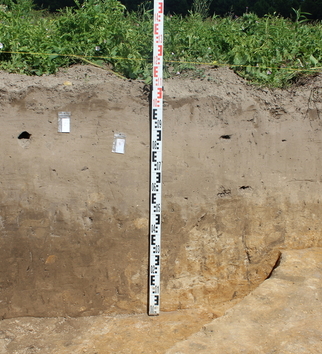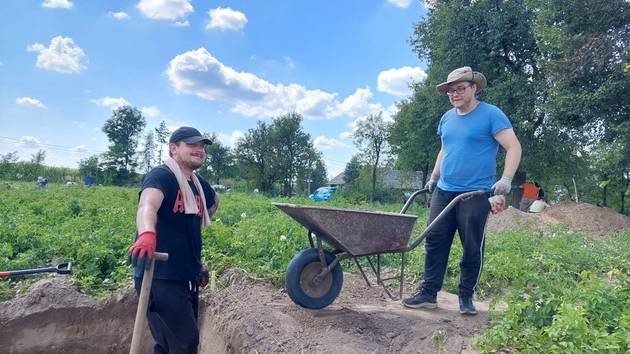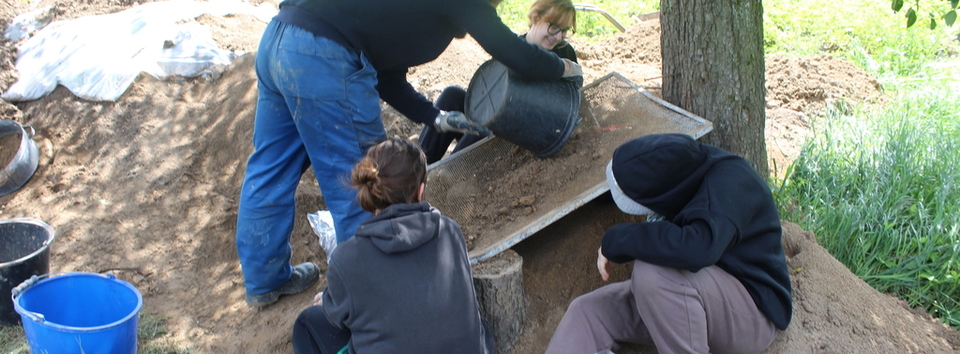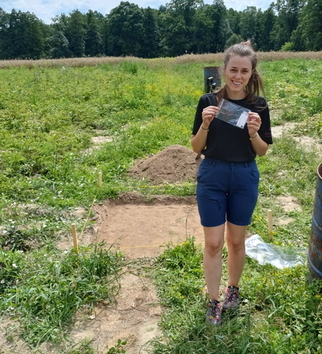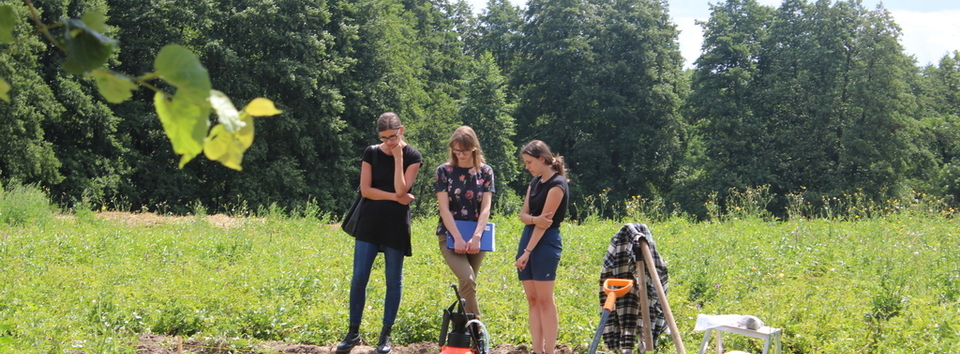This year's archaeological research in Jura was the next stage of the work undertaken in 2022 and continued in 2023. Their idea is the result of long-term cooperation with the local community of the municipalities of Lelów and Przyrów, established during the implementation of the NPRH Ministry of Science and Higher Education research project entitled "Miejsca pamięci i zapomnienia. Badania interdyscyplinarne północnych terenów Jury Krakowsko-Częstochowskiej" [Sites of Memory and Oblivion. Interdisciplinary research of the northern areas of the Krakow-Częstochowa Jurassicfrom 2014-2019]. The field research covered two archaeological sites: in Staromieście (Lelów municipality) in cooperation with the Lelów Historical and Cultural Society, and in Aleksandrówka (Przyrów muicipality) in cooperation with the Nuns of the Order of Preachers from the Monastery of St. Anne. The work was led by Dr Olgierd Ławrynowicz and mgr Anna Garstka with financial support from the Faculty of Philosophy and History of the University of Lodz and the Provincial Office for the Protection of Monuments in Katowice.
As in previous research seasons, our students participated in field work at both archaeological sites on a rotational basis. In Staromieście, they gained excavation experience under the supervision of mgr Anna Garstka, on the south-west side of the Church of the Assumption of the Blessed Virgin Mary, whose history dates back to the 12th century. The results of the research carried out so far from the other side of the church between 2022 and 2023 by mgr Radosław Zdaniewicz made it possible to confirm and at the same time recognise the north-eastern edge and north-western area of the early medieval settlement. As a result of these archaeological works, relics of a furnace, lead weights, silver coins, including a denarius of Władysław the Exile from the first half of the 12th century, an early medieval spur with a pyramidal, gilded spur, and a large number of fragments of vessel ceramics used in the early and late Middle Ages and in the modern period were found.
Two archaeological trenches were established during this year's survey to verify the south-western boundary of the settlement. In one of the trenches, a large object with a heterogeneous and mixed filling layer was discovered, in which a Jagiellonian denarius was found (most likely a denarius of Władysław of Varna from the 1st half of the 15th century) and a fragment of a ring.
The area of the St. Anne's Monastery in Aleksandrówka has been examined by employees of our Institute for the fifth time. In 2017, thanks to ethnographic interviews conducted in the Przyrów municipality by staff and students from the Institute of Ethnology and Cultural Anthropology at the University of Lodz, the lack of knowledge of local residents about the German war crime committed against 28 Polish civilians in the first days of September 1939 on the monastery grounds was revealed. One of the oldest living nuns of the Order of Preachers (Dominican Cloistered Nuns) at that time provided information that the commemoration, currently located at the southern wall of the monastery’s utility area, was erected in the 1960s, several dozen metres away from the actual grave, which, according to the interviewee, was located in the immediate vicinity of the dirt road leading from the monastery buildings.
The archival search carried out, in particular the files of the Branch Commission for the Prosecution of Crimes Against the Polish Nation in Katowice, showed that despite the initiation of an investigation into the German crime on the grounds of the St. Anne's monastery, no official field work was undertaken to determine the location of the grave and the number of victims. Archaeological surveys carried out in 2017 and 2019 did not confirm the presence of a burial pit (containing human remains or exhumed) within and in the vicinity of the current commemoration. Probing trenches and stirrup auger boreholes undertaken in anomalous areas identified by geophysical (GPR and electrical resistivity) analyses also did not lead to locating the sought-after burial pit.
The research undertaken in 2022–2023 was exceptionally intensive due to the use of mechanical equipment (mini-excavators), which made it possible to thoroughly examine the area where the original cross commemorating the grave was supposed to be located until the 1960s. Despite expanding the research area with a dense network of drilling holes and additional test trenches, it was not possible to confirm the location of the grave in this area. In 2023, new leads were additionally taken into account, resulting from the analysis of the acquired archival aerial photos of the research area (including those from September 1944) and the location of a cluster of a dozen or so German-made shell casings from 1936–1938 for the Mauser rifle, individual finds of ammunition boats and bullets from this weapon. The research was conducted with as many as three hypotheses regarding the course of the execution in September 1939 in mind.
In the spring and summer of 2024, supplementary research was carried out using stirrup augers in an area that was previously inaccessible because it was used as a monastery vegetable garden during the growing season. The research results indicate that although the execution itself probably took place in the monastery's farm area, the burial place of its victims is located elsewhere.
In the spring of 2024, ethnographic interviews were conducted again with the older nuns, but also with the inhabitants of the surrounding villages (Święta Anna and Aleksandrówka). The analysis of the prepared transcripts and documents collected from the interviewees drew the researchers’ attention to the area directly adjacent to the monastery church (at the chapel of St. Anne) on the northern side, where there is a commemoration of a Polish soldier who was supposedly buried there after his death during the fighting in early September 1939. It was already known that this commemoration was created spontaneously without any documented factual basis. It was therefore assumed that the victims of the Wehrmacht's mass murder could have been buried in this very place.
The aim of this year’s research was to verify this hypothesis in relation to the area adjacent to the contemporary commemoration of a Polish soldier on the northern side, in such a way as not to interfere with the structure and immediate surroundings of the existing war grave. In the two test trenches, the level of the modern churchyard was documented, in the area where – according to the parish registers of St. Dorothy in Przyrów – incidental burials were carried out during the 18th century. In total, the remains of at least 9 individuals of both sexes (adults and children) were discovered, with 6 of them discovered in their original arrangement, intact or partially disturbed by later excavations. The remains were not removed. The human bones that were found in the secondary deposit, after being documented, were solemnly reburied by Father Wojciech Ożóg, the monastery chaplain.
Above the level of the modern burial pits, functionally indeterminate limestone walls/paving and trenches containing backfill of modern waste: building ceramics (fragments of bricks, tiles, architectural details), vascular ceramics and glass (fragments of goblets, candlesticks, stained glass) have been preserved. Metal objects were also discovered in the trenches: the frame of a bipartite profiled buckle and Polish, Lithuanian and Prussian coins from the 17th-18th centuries. These relics are an extremely interesting representation of artefacts illustrating the everyday life of the Bernardine monks (who operated here until the 1860s) and deserve a separate study. Part of the necropolis was disturbed when creating modern ditches for stormwater drains and electrical installations. A Mosin rifle bullet was found in the fill of one of them, probably a relic of the battles fought here at the beginning of the World War I. An interesting fact is the discovered pre-war medallion with the image of "St. Anna Przyrowska", which will become a pattern for devotional articles offered by the nuns to pilgrims. During the research, a significant mixing of layers was revealed in the survey wall, located almost 3 meters away from the commemoration of the Polish soldier. Is this the northern end of a larger pit that could have held more than the remains of a single person? We hope that we will be able to check this in the next research season.
During the field exercises, our students not only participated in outdoor and office work, but also took part in hiking expeditions around the area, for which they obtained theoretical preparation by listening to a lecture by Dr Olgierd Ławrynowicz, Wiktoria Bednarska and Kamil Langier entitled "Miejsca pamięci i miejsca zapomnienia w gminie Mstów" [Places of memory and places of oblivion in the Mstów municipality] at the GOK in Mstów for students of the University of the Third Age in Częstochowa. As part of the “Collision with the Landscape” campaign, they admired less obvious relics of the Jurassic cultural heritage. They also visited, among others, Ostrężnik Castle in the Niegowa commune, the exhibition “The Great War in the Jura 1914–1918” in the Stary Młyn – Museum of Old Crafts in Żarki, the Jewish cemetery in Żarki, the castle in Olsztyn and a working limestone mine in Latosówka in the Mstów commune, where they listened to a lecture by Mariusz Palarz, deputy mine manager from CEMEX. The stay in the Jura also became an opportunity for long kayaking trips.
We also made plans for the next year's research. For this purpose, we visited the alleged burial site of a young couple in the forest near Biała Wielka near Lelów, who were killed by the Polish underground in 1944. Perhaps in the next research season we will also be able to verify this place archaeologically. As every year, we met with Mirosław Skrzypczyk, President of the Lelów Historical and Cultural Society, winner of the POLIN Award, with whom we discussed ideas for further Jurassic journeys to the past. During the research, we were also visited by our very nice graduates.
We'll be back next year!
Text and edit: mgr Anna Garstka, Dr Olgierd Ławrynowicz
Photos: W. Bednarska, A. Garstka, A. Golińska, K. Górka, K. Langier, O. Ławrynowicz




